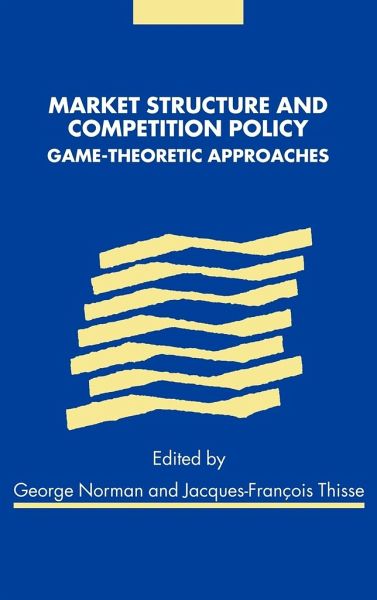
Market Structure and Competition Policy
Game-Theoretic Approaches
Herausgeber: Norman, George; Thisse, Jacques-Francois

PAYBACK Punkte
59 °P sammeln!
Market Structure and Competition Policy applies modern advances in game theory to the analysis of competition policy and develops some of the theoretical and policy concerns associated with the pioneering work of Louis Phlips. Containing contributions by leading scholars from Europe and North America, this book observes a common theme in the relationship between the regulatory regime and market structure. Since the inception of the new industrial organisation, economists have developed a better understanding of how real world markets operate. These results have particular relevance to the desi...
Market Structure and Competition Policy applies modern advances in game theory to the analysis of competition policy and develops some of the theoretical and policy concerns associated with the pioneering work of Louis Phlips. Containing contributions by leading scholars from Europe and North America, this book observes a common theme in the relationship between the regulatory regime and market structure. Since the inception of the new industrial organisation, economists have developed a better understanding of how real world markets operate. These results have particular relevance to the design and application of anti-trust policy. Analyses indicate that picking the most competitive framework in the short run may be detrimental to competition and welfare in the long run, concentrating the attention of policy makers on the impact on the long-run market structure. This book provides essential reading for graduate students of industrial and managerial economics as well as researchers and policy makers.
Table of contents:
Introduction; 1. Competition policy and game theory: reflection based on the cement industry case Claude d'Aspremont, David Encaoua and Jean-Pierre Ponssard; 2. Legal standards and economic analysis of collusion in the EC competition policy Damien J. Neven; 3. A guided tour of the folk theorem James W. Friedman; 4. Predatory pricing and anti-dumping P. K. M. Tharakan; 5. Should pricing policies be regulated when firms may tacitly collude? George Norman and Jacques-François Thisse; 6. Tougher price competition or lower concentration: a trade-off for antitrust authorities? Claude d'Aspremont and Massimo Motta; 7. The strategic effects of supply guarantees: the raincheck game Jonathan H. Hamilton; 8. Product market competition policy and technological performance Stephen Martin; 9. On some issues in the theory of competition in regulated markets Gianni de Fraja; 10. Modelling the entry and exit process in dynamic competition: an introduction to repeated commitment models Jean-Pierre Ponssard; 11. Coordination failures in the Cournot approach to deregulated bank competition André de Palma and Robert J. Gary-Bobo; 12. How the adoption of a new technology is affected by the interaction between labor and product markets Xavier Wauthy and Yves Zenou.
A wide-ranging contribution to the literature on industrial economics by leading scholars from Europe and North America, combining theory and applied case studies, on the sometimes surprising effects of competition or anti-trust policy on industry structure.
Applies modern advances in game theory to the analysis of competition policy.
Table of contents:
Introduction; 1. Competition policy and game theory: reflection based on the cement industry case Claude d'Aspremont, David Encaoua and Jean-Pierre Ponssard; 2. Legal standards and economic analysis of collusion in the EC competition policy Damien J. Neven; 3. A guided tour of the folk theorem James W. Friedman; 4. Predatory pricing and anti-dumping P. K. M. Tharakan; 5. Should pricing policies be regulated when firms may tacitly collude? George Norman and Jacques-François Thisse; 6. Tougher price competition or lower concentration: a trade-off for antitrust authorities? Claude d'Aspremont and Massimo Motta; 7. The strategic effects of supply guarantees: the raincheck game Jonathan H. Hamilton; 8. Product market competition policy and technological performance Stephen Martin; 9. On some issues in the theory of competition in regulated markets Gianni de Fraja; 10. Modelling the entry and exit process in dynamic competition: an introduction to repeated commitment models Jean-Pierre Ponssard; 11. Coordination failures in the Cournot approach to deregulated bank competition André de Palma and Robert J. Gary-Bobo; 12. How the adoption of a new technology is affected by the interaction between labor and product markets Xavier Wauthy and Yves Zenou.
A wide-ranging contribution to the literature on industrial economics by leading scholars from Europe and North America, combining theory and applied case studies, on the sometimes surprising effects of competition or anti-trust policy on industry structure.
Applies modern advances in game theory to the analysis of competition policy.




